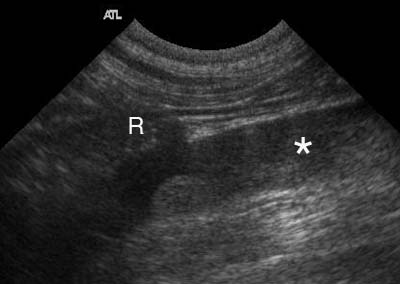The language of ultrasound The language of ultrasound is made up of descriptive words to try to form a picture in the reader's mind. Ultrasound waves are formed in the transducer (the instrument the radiologist applies to the body), and reflect from tissue interfaces that they pass through back to … [Read more...]
Biliary obstruction
Extrahepatic biliary obstruction is a reasonably common clinical scenario in older cats. Chronic cholangiohepatitis, pancreatitis and neoplasia can all cause bile duct obstruction with jaundice and high serum bilirubin. The bile duct can undergo a chronic partial obstruction from a mass or … [Read more...]
Gall bladder wall edema
Edema of the gall bladder wall looks like a hypoechoic layer between two hyperechcoic surfaces. It can be confused with a small amount of peritoneal effusion so look carefully at the neck and body. In the images here, you can see the anechoic peritoneal effusion surrounding the thickened gall … [Read more...]
Acute renal infarcts
Renal infarcts are often incidental findings in animals with chronic renal disease. Infarcts are caused by thrombi that occlude a blood vessel in the kidney. Most of the time, they are chronic and mainly made up of fibrous tissue. The classic appearance is of a hyperechoic, wedge shaped area with … [Read more...]
Ultrasound of arterial and venous thrombosis
Thrombosis is a complication of many diseases in veterinary medicine. Heart disease, protein losing nephropathy and steroid therapy or hyperadrenocorticism can all predispose an animal to arterial or venous thrombi. Many of the systemic vessels involved are located in the abdomen and visible on … [Read more...]
- 1
- 2
- 3
- …
- 7
- Next Page »




Recent Comments